Evaluation of Scenarios for the Application of the Future PM2.5 and PM10 Standards: A Case Study of Three Urban Areas in Romania and Implications for Public Policies
Abstract
1. Introduction
2. Materials and Methods
2.1. Study Area
2.2. Air Quality Data
2.3. Definition and Calculation of the Proposed Indicators
2.3.1. Definition and Calculation of the Excess Concentration (EC)
- daily concentration of PM (µg/m3)
- daily limit value (45 µg/m3 for PM10 and 25 µg/m3 for PM2.5)
- the duration in days when
2.3.2. Definition and Calculation of the Episode Index (EI)
- concentration on day i (µg/m3)
- alert threshold (Directive (EU) 2024/2881: ≥50 µg/m3 for PM2.5 and ≥90 µg/m3 for PM10).
- number of consecutive days during the pollution episode where .
2.3.3. Definition and Calculation of the Toxic Load Index (TLI)
- = TLI daily
- the PM2.5 concentration on day i, when the LV is exceeded (µg/m3)
- the ratio of concentrations on day i
- 25 (µg/m3) = daily limit value for PM2.5
3. Results
3.1. Measured Annual Mean Concentrations Compared with Current and Future LIMIT Value
3.1.1. Annual Mean Concentrations of PM10
3.1.2. Annual Mean Concentrations of PM2.5
3.2. Daily Exceedances Relative to Current and Future Daily Limit Values for PM10 and PM2.5
3.2.1. Analysis of Daily Exceedances for PM10
3.2.2. Analysis of Daily Exceedances for PM2.5
3.3. Proposed Supplementary Indicators for PM10 and PM2.5
3.3.1. Excess Concentration
3.3.2. Episode Index (EI)
3.3.3. Toxic Load Index (TLI)
4. Discussion
4.1. Projected Compliance Under Directive (EU) 2024/2881
4.2. Added Value of EC, EI, and TLI
4.3. Policy Implications
5. Conclusions
Supplementary Materials
Author Contributions
Funding
Data Availability Statement
Acknowledgments
Conflicts of Interest
Abbreviations
| AQG | Air Quality Guidelines |
| EC | Excess Concentration |
| EI | Episode Index |
| PM | Particulate matter |
| TLI | Toxic Load Index |
| WHO | World Health Organization |
References
- European Environment Agency. The European Environment-State and Outlook 2020. Knowledge for Transition to a Sustainable Europe; EEA: Copenhagen, Denmark, 2020; Volume 60, ISBN 9789294800909. [Google Scholar] [CrossRef]
- World Health Organization. WHO Global Air Quality Guidelines: Particulate Matter (PM2.5 and PM10), Ozone, Nitrogen Dioxide, Sulfur Dioxide and Carbon Monoxide: Executive Summary; World Health Organization: Geneva, Switzerland, 2021; ISBN 978-92-4-003443-3. [Google Scholar]
- European Environment Agency. Premature Deaths Caused by Environmental Pollution. European Zero Pollution Dashboards. 2025. Available online: https://www.eea.europa.eu/en/european-zero-pollution-dashboards/indicators/premature-deaths-as-a-result-of-environmental-pollution (accessed on 30 July 2025).
- European Environment Agency. Air Quality Status Report 2025. 2025. Available online: https://www.eea.europa.eu/en/analysis/publications/air-quality-status-report-2025 (accessed on 15 August 2025).
- European Commission. 2025 Environmental Implementation Review - Country Report: ROMANIA; Commission Staff Working Document, SWD(2025) 322 final, Brussels, 7 July 2025; Publications Office of the European Union: Luxembourg, 2025; Available online: https://environment.ec.europa.eu/publications/2025-environmental-implementation-review-country-report-romania_en (accessed on 15 May 2025).
- Philip, S.; Martin, R.V.; Snider, G.; Weagle, C.L.; Van Donkelaar, A.; Brauer, M.; Henze, D.K.; Klimont, Z.; Venkataraman, C.; Guttikunda, S.K.; et al. Anthropogenic fugitive, combustion and industrial dust is a significant, underrepresented fine particulate matter source in global atmospheric models. Environ. Res. Lett. 2017, 12, 044018. [Google Scholar] [CrossRef]
- Van Den Heuvel, R.; Staelens, J.; Koppen, G.; Schoeters, G. Toxicity of urban PM10 and relation with tracers of biomass burning. Int. J. Environ. Res. Public Health 2018, 15, 320. [Google Scholar] [CrossRef]
- Directive (EU) 2024/2881 of the European Parliament and of the Council of 23 October 2024 on Ambient Air Quality and Cleaner Air for Europe (Recast). Official Journal of the European Union 2024, L, 2024/2881. Available online: https://eur-lex.europa.eu/legal-content/EN/TXT/?uri=CELEX:32024L2881 (accessed on 1 May 2025).
- Directive 2008/50/EC of the European Parliament and of the Council of 21 May 2008 on Ambient Air Quality and Cleaner Air for Europe. Official Journal of the European Union 2008, L 152, 1–44. Available online: https://eur-lex.europa.eu/legal-content/EN/TXT/?uri=CELEX:32008L0050 (accessed on 1 May 2025).
- Pražnikar, Z.J.; Pražnikar, J. The effects of particulate matter air pollution on respiratory health and on the cardiovascular system. Zdr. Varst. 2012, 51, 190–199. [Google Scholar] [CrossRef]
- Park, J.; Kim, H.J.; Lee, C.H.; Lee, C.H.; Lee, H.W. Impact of long-term exposure to ambient air pollution on the incidence of chronic obstructive pulmonary disease: A systematic review and meta-analysis. Environ. Res. 2021, 194, 110703. [Google Scholar] [CrossRef] [PubMed]
- Taj, T.; Poulsen, A.H.; Ketzel, M.; Geels, C.; Brandt, J.; Christensen, J.H.; Puett, R.; Hvidtfeldt, U.A.; Sørensen, M.; Raaschou-Nielsen, O. Exposure to PM2.5 constituents and risk of adult leukemia in Denmark: A population-based case–control study. Environ. Res. 2021, 196, 110418. [Google Scholar] [CrossRef] [PubMed]
- Ayres, J.G. Review of the UK Air Quality Index: Committee on the Medical Effects of Air Pollutants (COMEAP); Health Protection Agency: London, UK, 2011. Available online: https://www.gov.uk/government/publications/comeap-review-of-the-uk-air-quality-index (accessed on 28 May 2025).
- Kappos, A.D.; Bruckmann, P.; Eikmann, T.; Englert, N.; Heinrich, U.; Höppe, P.; Koch, E.; Krause, G.H.M.; Kreyling, W.G.; Rauchfuss, K.; et al. Report The German view Health effects of particles in ambient air. Int. J. Hyg. Environ. Health 2004, 207, 399–407. [Google Scholar] [CrossRef]
- Brunekreef, B.; Forsberg, B. Epidemiological evidence of effects of coarse airborne particles on health. Eur. Respir. J. 2005, 26, 309–318. [Google Scholar] [CrossRef]
- Pini, L.; Giordani, J.; Gardini, G.; Concoreggi, C.; Pini, A.; Perger, E.; Vizzardi, E.; Di Bona, D.; Cappelli, C.; Ciarfaglia, M.; et al. Emergency department admission and hospitalization for COPD exacerbation and particulate matter short-term exposure in Brescia, a highly polluted town in northern Italy. Respir. Med. 2021, 179, 106334. [Google Scholar] [CrossRef]
- Abbey, D.E.; Euler, G.L.; Moore, J.K.; Petersen, F.; Hodgkin, J.E.; Magie, A.R. Applications of a method for setting air quality standards based on epidemiological data. J. Air Pollut. Control Assoc. 1989, 39, 437–445. [Google Scholar] [CrossRef]
- Park, M.; Joo, H.S.; Lee, K.; Jang, M.; Kim, S.D.; Kim, I.; Borlaza, L.J.S.; Lim, H.; Shin, H.; Chung, K.H.; et al. Differential toxicities of fine particulate matters from various sources. Sci. Rep. 2018, 8, 17007. [Google Scholar] [CrossRef]
- Dai, L.; Zanobetti, A.; Koutrakis, P.; Schwartz, J.D. Associations of fine particulate matter species with mortality in the united states: A multicity time-series analysis. Environ. Health Perspect. 2014, 122, 837–842. [Google Scholar] [CrossRef]
- Dragoi (Oniu), L.; Breabăn, I.G.; Cazacu, M.M. 2017–2020 trends of particulate matter PM10 concentrations in the cities of Suceava and Botoșani. Present Environ. Sustain. Dev. 2023, 17, 335–349. [Google Scholar] [CrossRef]
- Drăgoi (Oniu), L.; Cazacu, M.-M.; Breabăn, I.-G. Analysis of the PM2.5/PM10 Ratio in Three Urban Areas of Northeastern Romania. Atmosphere 2025, 16, 720. [Google Scholar] [CrossRef]
- Mayor of Suceava Municipality, Air Quality Plan in Suceava Municipality for PM10 Particulate Matter, 2023–2027 Period 2023–2027. Available online: https://primariasv.ro/dm_suceava/site.nsf/atasament/77984F10279689EBC2258CAE0032003C/$FILE/PCA%20municipiul%20Suceava%202023_2027_avizat.pdf?Open (accessed on 14 June 2025). (In Romanian).
- Mayor of Iasi Municipality. Integrated Air Quality Plan for Iasi Municipality for Nitrogen Dioxide and Nitrogen Oxides (NO2/NOX) and Particulate Matter Indicators, Period 2024–2028. Available online: https://www.primaria-iasi.ro/dm_iasi/portal.nsf/pagini/planuri+de+calitatea+a+aerului-0001465A?Open (accessed on 14 June 2025). (In Romanian).
- Lu, F.; Xu, D.; Cheng, Y.; Dong, S.; Guo, C.; Jiang, X.; Zheng, X. Systematic review and meta-analysis of the adverse health effects of ambient PM2.5 and PM10 pollution in the Chinese population. Environ. Res. 2015, 136, 196–204. [Google Scholar] [CrossRef] [PubMed]
- Li, Z.; Yang, X. Ratio of PM2.5 to PM10 Mass Concentrations in Beijing and Relationships with Pollution from the North China Plain. Asia-Pacific J. Atmospheric Sci. 2020, 57, 421–434. [Google Scholar] [CrossRef]
- Tanasa, I.; Cazacu, M.; Sluser, B. Air Quality Integrated Assessment: Environmental Impacts, Risks and Human Health Hazards. Appl. Sci. 2023, 13, 1222. [Google Scholar] [CrossRef]
- Cazacu, M.-M.; Schiopu Catalin Emil, R.C. Politica Publică Alternativă Pentru Măsuri Integrate de Reducere a Poluării Aerului; StudIS: Iasi, Romania, 2024; ISBN 9196320559. [Google Scholar]
- Cariolet, J.M.; Colombert, M.; Vuillet, M.; Diab, Y. Assessing the resilience of urban areas to traffic-related air pollution: Application in Greater Paris. Sci. Total Environ. 2018, 615, 588–596. [Google Scholar] [CrossRef]
- Kobza, J.; Geremek, M.; Dul, L. Characteristics of air quality and sources affecting high levels of PM10 and PM2.5 in Poland, Upper Silesia urban area. Environ. Monit. Assess. 2018, 190, 515. [Google Scholar] [CrossRef]
- Volná, V.; Blažek, Z. Contribution to the study of possible transport of PM10 aerosols in the eastern part of the Czech Republic. Heliyon 2024, 10, e36850. [Google Scholar] [CrossRef]
- Mecca, D.; Boanini, C.; Vaccaro, V.; Gallione, D.; Mastromatteo, N.; Clerico, M. Spatial variation, temporal evolution, and source direction apportionment of PM1, PM2.5, and PM10: 3-year assessment in Turin (Po Valley). Environ. Monit. Assess. 2024, 196, 1251. [Google Scholar] [CrossRef]
- Progiou, A.; Liora, N.; Sebos, I.; Chatzimichail, C.; Melas, D. Measures and Policies for Reducing PM Exceedances through the Use of Air Quality Modeling: The Case of Thessaloniki, Greece. Sustainability 2023, 15, 930. [Google Scholar] [CrossRef]
- Wu, Q.; Wang, Z.; Gbaguidi, A.; Tang, X.; Zhou, W. Numerical study of the effect of traffic restriction on air quality in beijing. Sci. Online Lett. Atmos. 2010, 6A, 17–20. [Google Scholar] [CrossRef]
- Zhao, S.; Yu, Y. Effect of short-term regional traffic restriction on urban submicron particulate pollution. J. Environ. Sci. 2017, 55, 86–99. [Google Scholar] [CrossRef] [PubMed]
- Kryłów, M.; Generowicz, A. Impact of Street Sweeping and Washing on the PM10 and PM2.5 Concentrations in Cracow (Poland). Rocz. Ochr. Sr. 2019, 29, 691–711. [Google Scholar]
- Fensterer, V.; Küchenhoff, H.; Maier, V.; Wichmann, H.E.; Breitner, S.; Peters, A.; Gu, J.; Cyrys, J. Evaluation of the impact of low emission zone and heavy traffic ban in Munich (Germany) on the reduction of PM10 in ambient air. Int. J. Environ. Res. Public Health 2014, 11, 5094–5112. [Google Scholar] [CrossRef]
- Cyrys, J.; Peters, A.; Soentgen, J.; Wichmann, H.E. Low emission zones reduce PM10 mass concentrations and diesel soot in German cities. J. Air Waste Manag. Assoc. 2014, 64, 481–487. [Google Scholar] [CrossRef]
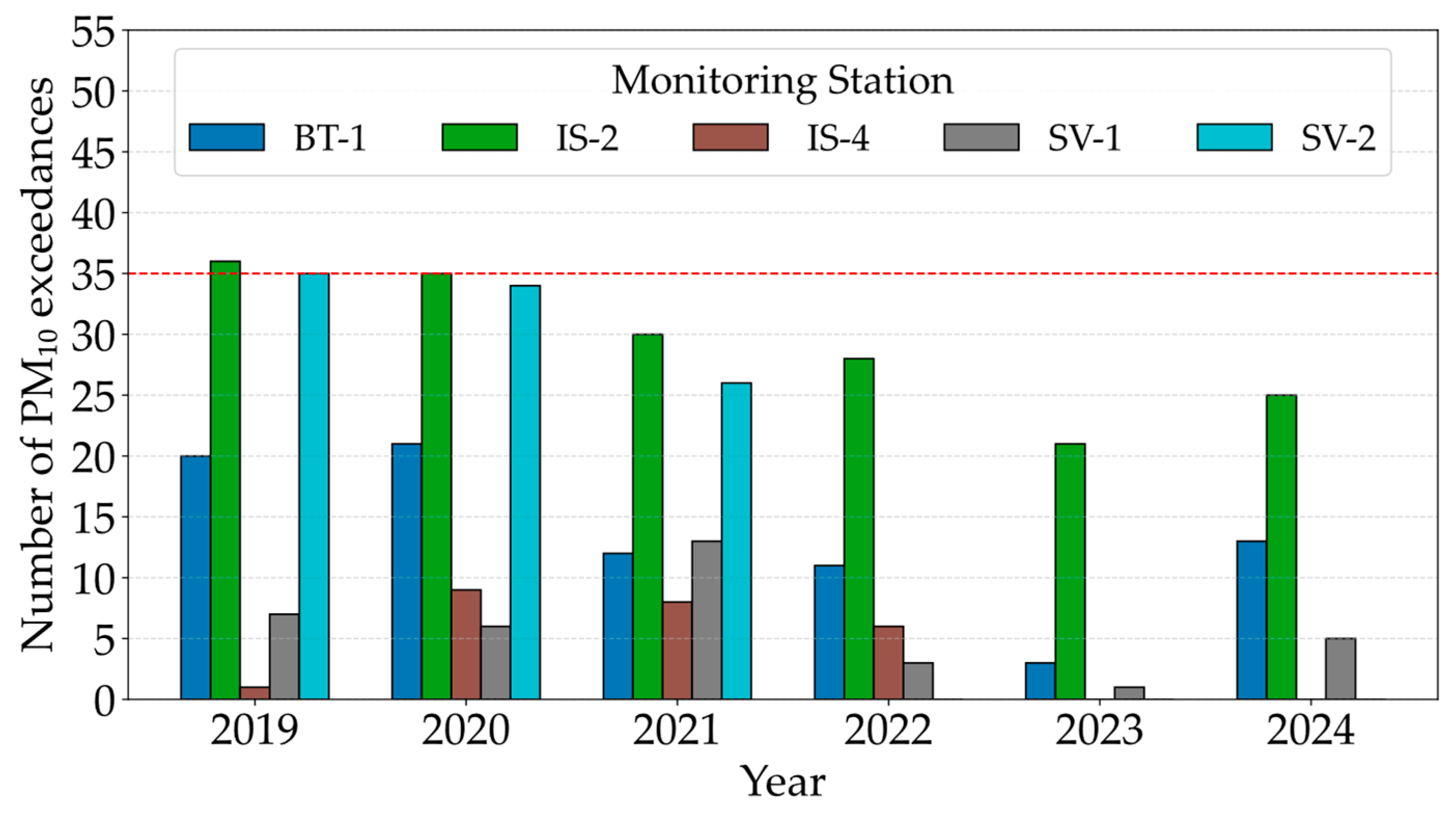
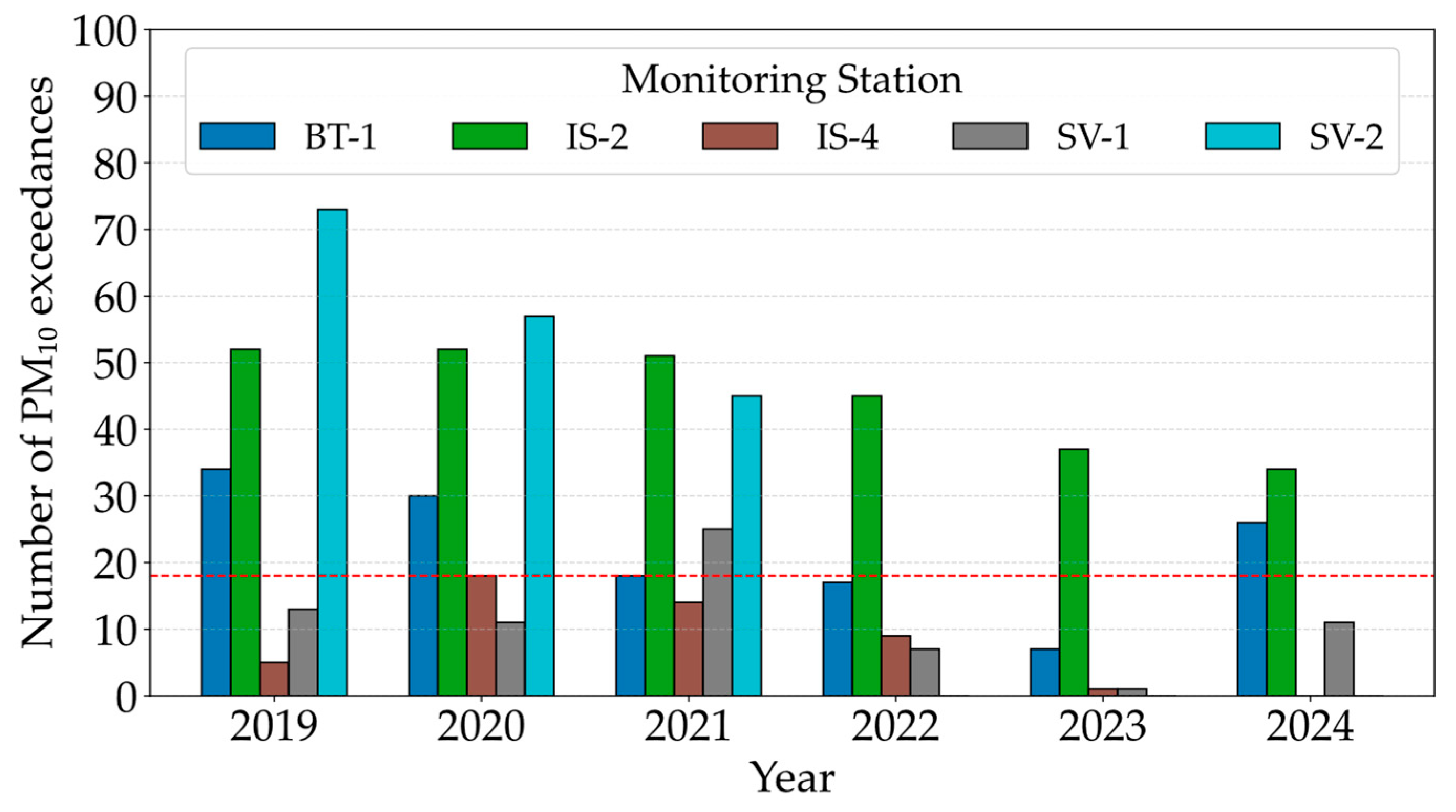
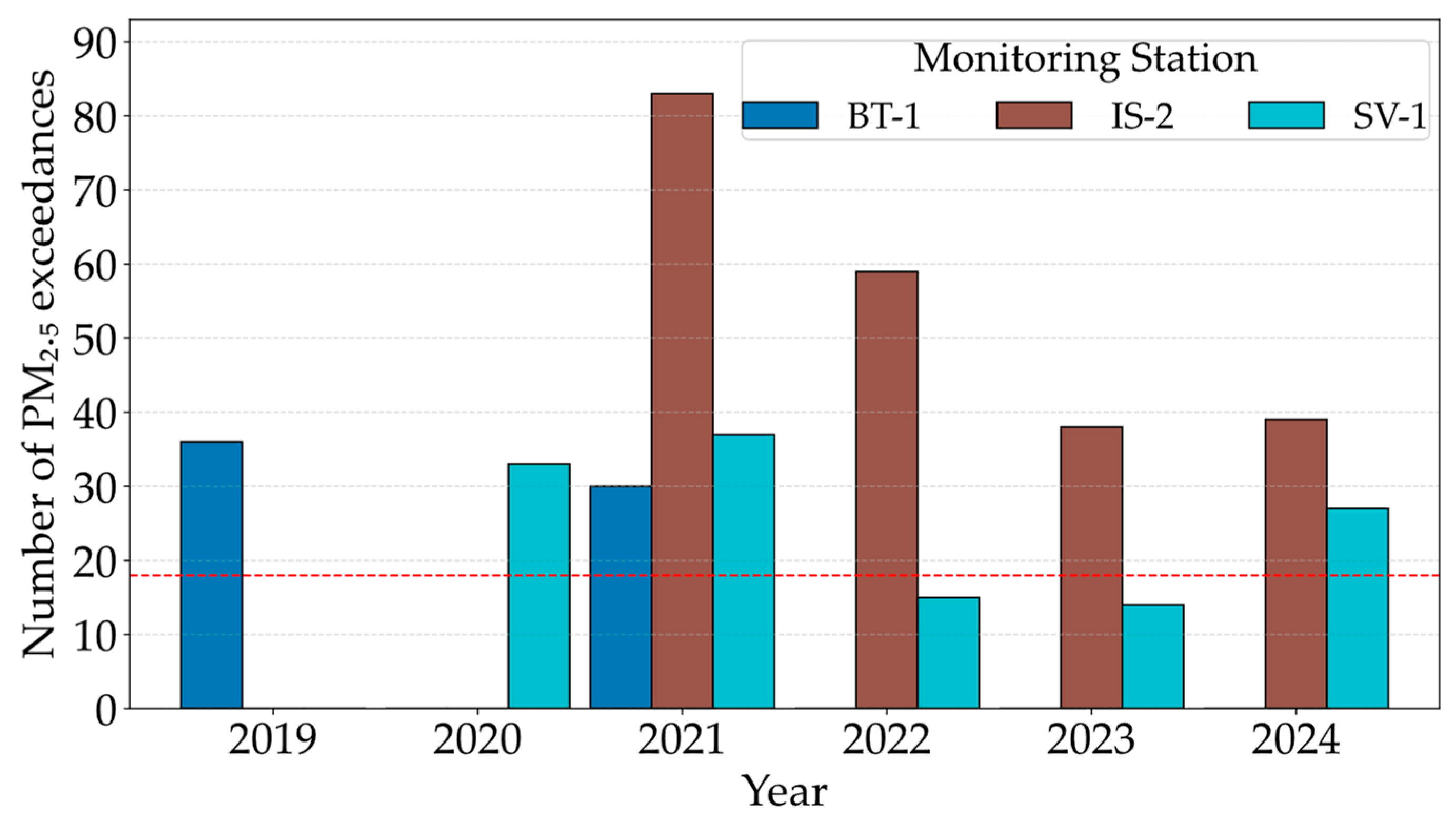
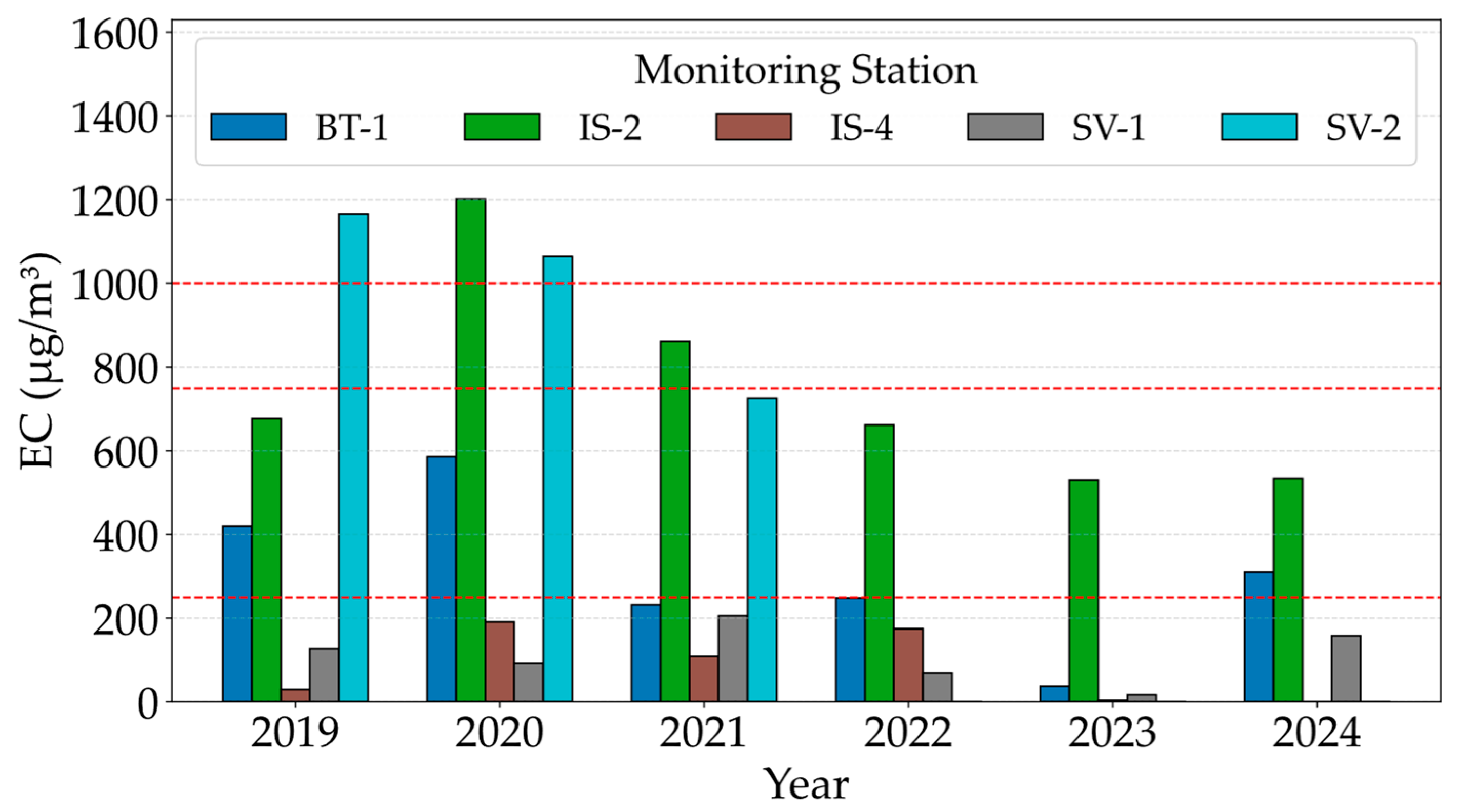
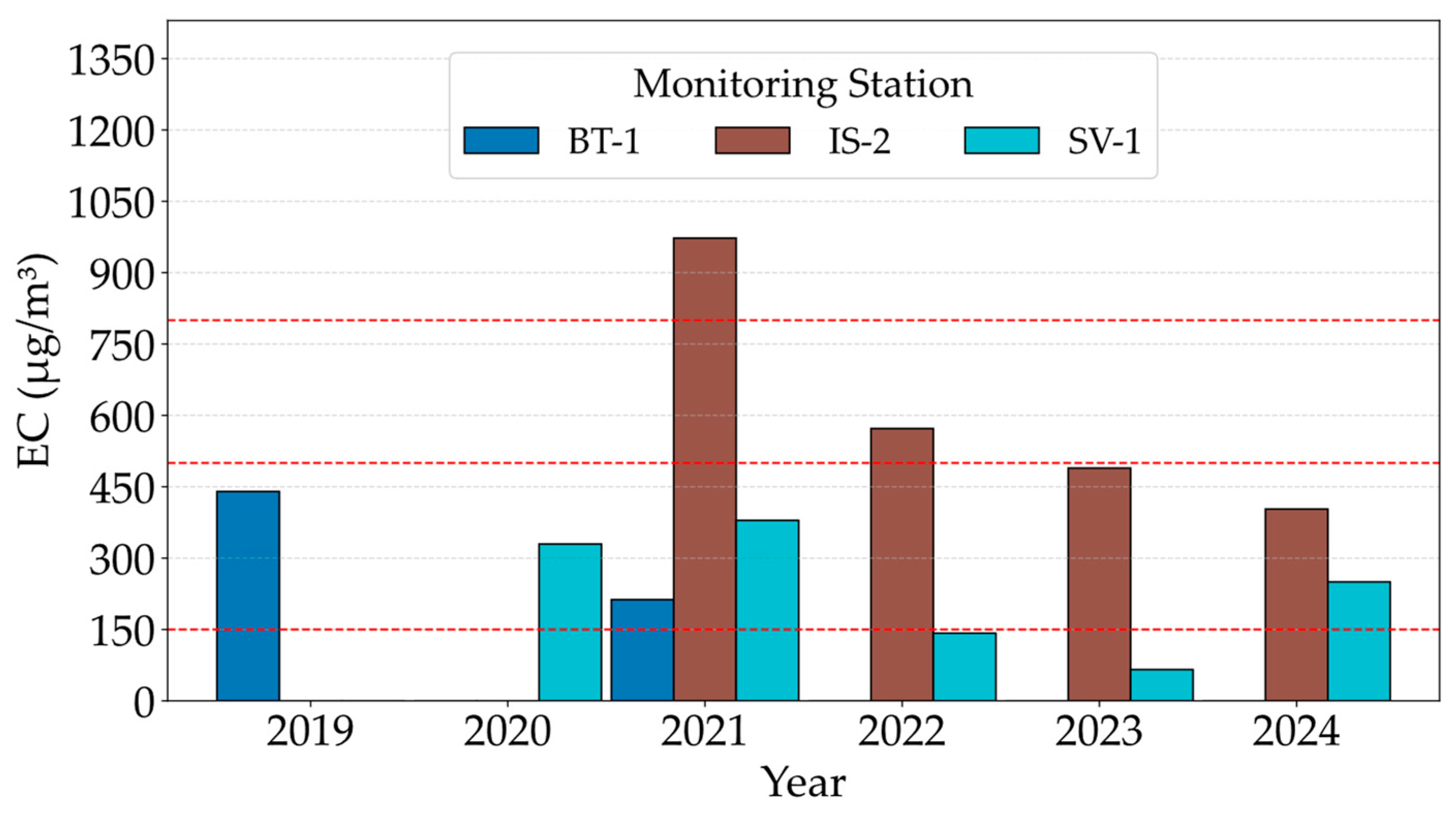


| Pollutant | Averaging Period | Directive 2008/50/EC * | Directive (EU) 2024/2881 ** | WHO, 2021 Recommended |
|---|---|---|---|---|
| Limit Value | AQG Level | |||
| PM2.5 µg/m3 | Calendar year | 25 | 10 | 5 |
| 1 day | - | 25 not to be exceeded more than 18 times per calendar year | 15 not to be exceeded more than 3–4 times per calendar year | |
| PM10 µg/m3 | Calendar year | 40 | 20 | 15 |
| 1 day | 50 not to be exceeded more than 35 times per calendar year | 45 not to be exceeded more than 18 times per calendar year | 45 not to be exceeded more than 3–4 times per calendar year | |
| Pollutant | Averaging Period | Directive (EU) 2024/2881 |
|---|---|---|
| PM2.5 | 1 day | 50 µg/m3 |
| PM10 | 1 day | 90 µg/m3 |
| Station | Latitude | Longitude | Altitude | |
|---|---|---|---|---|
| Suceava | SV-1 | 47.649259° N | 26.249009° E | 376 m |
| SV-2 1 | 47.668825° N | 26.281403° E | 289 m | |
| Botoșani | BT-1 | 47.739945° N | 26.658999° E | 167 m |
| Iasi | IS-2 | 47.150951° N | 27.581920° E | 42 m |
| IS-4 1 | 47.213306° N | 27.611074° E | 186 m | |
| Category | Annual EC (µg/m3) PM10 | Annual EC (µg/m3) PM2.5 | Interpretation Criteria |
|---|---|---|---|
| Low | <250 | <150 | Less than 18 daily exceedances or low-magnitude exceedances |
| Moderate | 251–750 | 151–500 | Frequent moderate daily exceedances, slightly above the limit value and/or occasional high daily exceedances |
| High | 751–1000 | 501–800 | Frequent daily exceedances and/or high daily concentration levels |
| Very high | >1000 | >800 | Severe pollution with numerous daily exceedances or extreme episodes |
| Category | EI (µg/m3) PM10 | EI (µg/m3) PM2.5 | Interpretation Criteria |
|---|---|---|---|
| High | 1–25 | 1–25 | 2–3 consecutive days with concentrations close to 90 µg/m3 for PM10, 50 µg/m3 for PM2.5 |
| Very high | 26–100 | 26–100 | 3–4 consecutive days with concentrations around 100–115 µg/m3 for PM10, 60–70 µg/m3 for PM2.5 |
| Extremely high | >101 | >101 | Long episodes and/or high peaks (>115 µg/m3 for PM10, >75–90 µg/m3 for PM2.5). |
| Category | TLI (µg/m3) | Interpretation Criteria |
|---|---|---|
| No risk | 0 | PM2.5 below the daily limit value (25 µg/m3), insignificant toxic load |
| Low | 0.1–5 | Slight exceedance or a lower PM2.5/PM10 ratio |
| Moderate | 5.1–12 | Significant exceedance and a high PM2.5/PM10 ratio |
| High | 12.1–20 | Severe pollution episodes with toxic composition |
| Very high | >20 | Critical episode, major toxicological risk |
| Year | BT-1 | IS-2 | IS-4 | SV-1 | SV-2 | Directive 2008/50/EC | Directive (EU) 2024/2881 |
|---|---|---|---|---|---|---|---|
| PM10 | |||||||
| µg/m3 | µg/m3 | µg/m3 | µg/m3 | µg/m3 | LV | LV | |
| 2019 | 27.30 | 32.10 | 20.22 | 22.60 | 32.87 | 40 µg/m3 | 20 µg/m3 |
| 2020 | 25.15 | 30.43 | 20.68 | 20.75 | 30.51 | ||
| 2021 | 23.27 | 30.73 | 20.47 | 22.29 | 28.54 | ||
| 2022 | 21.70 | 29.60 | 18.34 | 17.88 | - | ||
| 2023 | 20.72 | 27.18 | 18.62 | 18.53 | - | ||
| 2024 | 26.23 | 27.53 | - | 21.39 | - | ||
| Year | BT-1 | IS-2 | SV-1 | Directive 2008/50/EC | Directive (UE) 2024/2881 |
|---|---|---|---|---|---|
| PM2.5 | |||||
| µg/m3 | µg/m3 | µg/m3 | LV | LV | |
| 2019 | 13.34 | - | - | 25 µg/m3 | 10 µg/m3 |
| 2020 | - | - | 14.47 | ||
| 2021 | 13.74 | 20.21 | 15.14 | ||
| 2022 | - | 18.02 | 12.12 | ||
| 2023 | - | 14.91 | 11.23 | ||
| 2024 | - | 15.50 | 13.75 | ||
| Scenario | Reclassifications | Reclassification Details (Station/Year) | Stability (%) |
|---|---|---|---|
| All thresholds decrease by 10% | 4 | BT-1(2021,2022) IS-2 (2019), SV-2(2021) | 84.62 |
| All thresholds decrease by 20% | 7 | BT-1(2021,2022), IS-2 (2019, 2021, 2022) SV-1 (2021), SV-2(2021) | 73.08 |
| All thresholds increase by 10% | 1 | SV-2(2020) | 96.15 |
| All thresholds increase by 20% | 3 | SV-2(2019, 2020) IS-2 (2021) | 88.46 |
| Only the lower threshold decreases by 10% | 2 | BT-1(2021,2022) | 92.31 |
| Only the lower threshold decreases by 20% | 3 | BT-1(2021,2022) SV-1(2021) | 88.46 |
| Only the lower threshold increases by 10% | 0 | - | 100 |
| Only the lower threshold increases by 20% | 0 | - | 100 |
| Scenario | Reclassifications | Reclassification Details (Station/Year) | Stability (%) |
|---|---|---|---|
| All thresholds decrease by 10% | 2 | SV-1(2022), IS-2 (2023) | 81.82 |
| All thresholds decrease by 20% | 4 | BT-1(2019), IS-2 (2023, 2024) SV-1 (2022) | 63.64 |
| All thresholds increase by 10% | 0 | - | 100 |
| All thresholds increase by 20% | 1 | IS-2 (2022) | 90.91 |
| Only the lower threshold decreases by 10% | 1 | SV-1(2022) | 90.91 |
| Only the lower threshold decreases by 20% | 1 | SV-1(2022) | 90.91 |
| Only the lower threshold increases by 10% | 0 | - | 100 |
| Only the lower threshold increases by 20% | 0 | - | 100 |
| Station | Start Date | End Date | Duration (Days) | Mean Exceedance (µg/m3) | EI (µg/m3) | EI Classification |
|---|---|---|---|---|---|---|
| SV-2 | 08-01-2020 | 10-01-2020 | 3 | 22.11 | 66.33 | Very high |
| IS-2 | 09-01-2020 | 10-01-2020 | 2 | 6.56 | 13.11 | High |
| SV-2 | 25-01-2020 | 28-01-2020 | 4 | 8.89 | 35.56 | Very high |
| IS-2 | 25-01-2020 | 28-01-2020 | 4 | 6.42 | 25.68 | Very high |
| BT-1 | 26-11-2020 | 27-11-2020 | 2 | 7.69 | 15.37 | High |
| IS-2 | 26-11-2020 | 28-11-2020 | 3 | 8.61 | 25.83 | Very high |
| IS-2 | 24-02-2021 | 26-02-2021 | 3 | 23.34 | 70.03 | Very high |
| Station | Start Date | End Date | Duration (Days) | Mean Exceedance (µg/m3) | EI (µg/m3) | EI Classification |
|---|---|---|---|---|---|---|
| BT-1 | 06-12-2019 | 08-12-2019 | 3 | 28.12 | 84.36 | Very high |
| SV-1 | 26-01-2020 | 27-01-2020 | 2 | 4.85 | 9.7 | High |
| BT-1 | 26-11-2020 | 27-11-2020 | 2 | 17.45 | 34.9 | Very high |
| SV-1 | 26-11-2020 | 27-11-2020 | 2 | 5.07 | 10.14 | High |
| SV-1 | 19-01-2021 | 20-01-2021 | 2 | 7.15 | 14.3 | High |
| IS-2 | 23-02-2021 | 26-02-2021 | 4 | 26.46 | 105.82 | Extremely high |
| BT-1 | 13-11-2021 | 14-11-2021 | 2 | 16.64 | 33.28 | Very high |
| IS-2 | 15-03-2022 | 16-03-2022 | 2 | 8.97 | 17.94 | High |
| IS-2 | 09-02-2023 | 11-02-2023 | 3 | 22.58 | 67.74 | Very high |
| IS-2 | 29-12-2023 | 30-12-2023 | 2 | 7.61 | 15.22 | High |
| IS-2 | 06-11-2024 | 08-11-2024 | 3 | 15.22 | 45.66 | Very high |
| City (Station Examples) | PM10 Exceedances * | PM2.5 Exceedances ** | EC Categories | EI Highlights |
|---|---|---|---|---|
| Iași (IS-2) | Frequent (≥50 days in 2019–2021) | Up to 83 days (2021) | PM10–ranges from Very High (2020) to Moderate (2022–2024) PM2.5 ranges from Very High (2021) to Moderate (2023, 2024) | Severe episodes, including one extreme PM2.5 event (EI = 106 µg/m3) |
| Suceava (SV-2, SV-1) | Very high at SV-2 (73 days in 2019); Low at SV-1 (≤20 days in 2022–2024) | Up to 37 days SV-1 (2021) | PM10—ranges from Very High SV-2 (2019, 2020) to Low (SV-1) PM2.5 (SV-1)—ranges from Moderate (2020, 2021, 2024) to Low (2022, 2023) | Episodic PM10 peaks at SV-2; minor episodes at SV-1 |
| Botoșani (BT-1) | Moderate (≤30 days in 2021–2024) | Up to 36 days (2019) | Moderate to Low | Occasional moderate PM2.5 episodes |
Disclaimer/Publisher’s Note: The statements, opinions and data contained in all publications are solely those of the individual author(s) and contributor(s) and not of MDPI and/or the editor(s). MDPI and/or the editor(s) disclaim responsibility for any injury to people or property resulting from any ideas, methods, instructions or products referred to in the content. |
© 2025 by the authors. Licensee MDPI, Basel, Switzerland. This article is an open access article distributed under the terms and conditions of the Creative Commons Attribution (CC BY) license (https://creativecommons.org/licenses/by/4.0/).
Share and Cite
Drăgoi, L.; Cazacu, M.-M.; Breabăn, I.-G. Evaluation of Scenarios for the Application of the Future PM2.5 and PM10 Standards: A Case Study of Three Urban Areas in Romania and Implications for Public Policies. Environments 2025, 12, 373. https://doi.org/10.3390/environments12100373
Drăgoi L, Cazacu M-M, Breabăn I-G. Evaluation of Scenarios for the Application of the Future PM2.5 and PM10 Standards: A Case Study of Three Urban Areas in Romania and Implications for Public Policies. Environments. 2025; 12(10):373. https://doi.org/10.3390/environments12100373
Chicago/Turabian StyleDrăgoi (Oniu), Liliana, Marius-Mihai Cazacu, and Iuliana-Gabriela Breabăn. 2025. "Evaluation of Scenarios for the Application of the Future PM2.5 and PM10 Standards: A Case Study of Three Urban Areas in Romania and Implications for Public Policies" Environments 12, no. 10: 373. https://doi.org/10.3390/environments12100373
APA StyleDrăgoi, L., Cazacu, M.-M., & Breabăn, I.-G. (2025). Evaluation of Scenarios for the Application of the Future PM2.5 and PM10 Standards: A Case Study of Three Urban Areas in Romania and Implications for Public Policies. Environments, 12(10), 373. https://doi.org/10.3390/environments12100373








